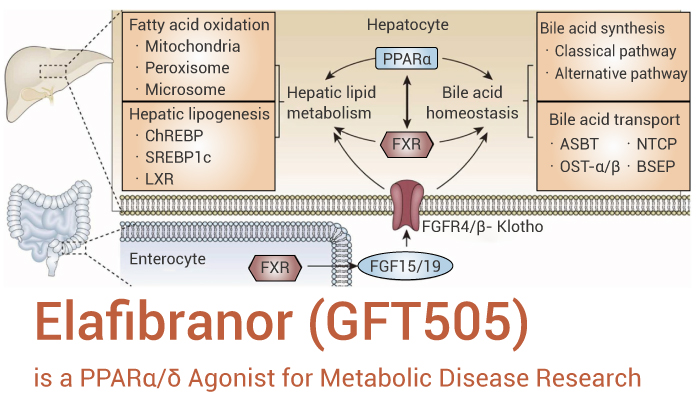PPAR, or peroxisome proliferator-activated receptor, involves in the regulation of glucose homeostasis, lipid metabolism, and vascular inflammation. PPAR-α, also known as NR1C1, is a nuclear receptor protein. It is the first member of the PAR family to be identified as a nuclear receptor for several rodent liver carcinogens. And leading to peroxisome proliferation. PPAR-δ, also known as PPAR-β, may be associated with diabetes, obesity, atherosclerosis, and cancer. In adipose tissue, PPAR-β/δ increase oxidation and uncoupling of oxidative phosphorylation. Here, we’ll introduce a potent agonist of PPAR-α/δ, Elafibranor (GFT505).

Elafibranor (GFT505) is a PPAR-α/PPAR-δ dual agonist that can improve diabetes and control blood sugar and blood lipids.
Firstly, Elafibranor is a liver-targeted PPAR agonist with preferential activity on PPAR-α (EC50=45 nM) and additional activity on PPAR-δ (EC50=175 nM).
Elafibranor improves dyslipidemia, hepatic and peripheral insulin sensitivity, and liver enzymes. It has beneficial effects on glucose homeostasis by inhibiting hepatic gluconeogenesis. In toxicology studies in cynomolgus monkeys, Elafibranor (3, 10 and 50 mg/kg/d; po; qd for 12 weeks) demonstrates an excellent cardiac safety margin up to 50 mg/kg/d. It (10 and 30 mg/kg/d; po; qd for 8 weeks) also demonstrates efficacy and safety in the type 2 diabetes mellitus (T2DM) db/db mouse model, improving glycemic control and lipid profile. Elafibranor (10 and 30 mg/kg/d; po) effectively antagonizes pyruvate-induced hepatic gluconeogenesis and inhibits hepatic gluconeogenesis during pyruvate challenge (14 d) and oral glucose tolerance test (43 d and 56 d). Moreover, it results inhibition of gluconeogenic enzymes expression and improvement of glucose tolerance in challenges.
In summary, Elafibranor is an orally available dual PPAR-α/PPAR-δ agonist that can effectively inhibit gluconeogenic enzymes, used for T2DM research.
References:
[1]. Liu ZM, et al. Expert Opin Investig Drugs. 2015 May;24(5):611-21.
[2]. Hanf R, et al. Diab Vasc Dis Res. 2014.